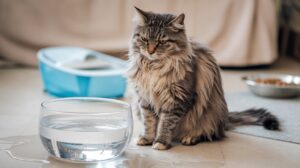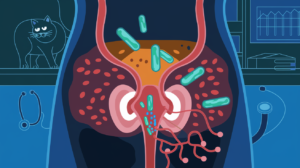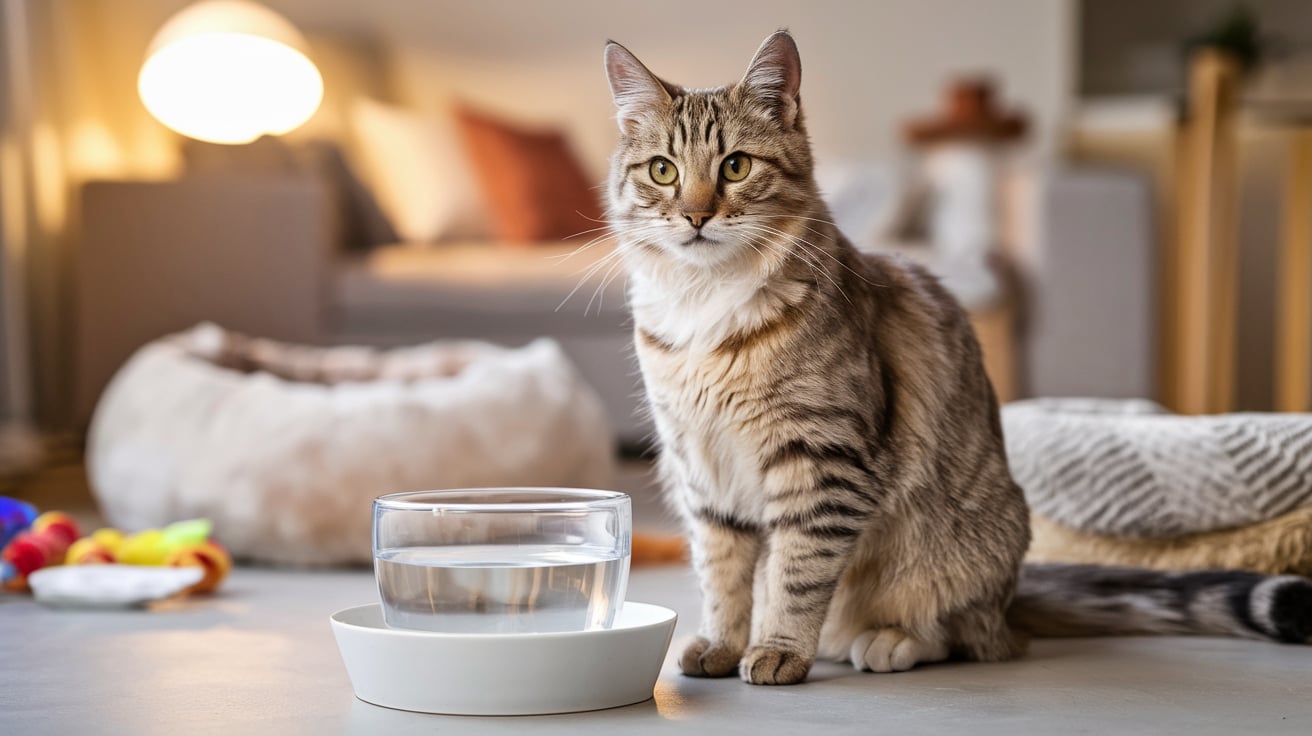Introduction
Cats, like humans, rely on water to maintain essential bodily functions, but they tend to drink less, making it important to monitor their intake. If you’re wondering, “Why is my cat drinking so much water?”, it’s essential to understand their hydration needs. Typically, a healthy cat should consume about 50 to 60 milliliters of water per kilogram of body weight daily. Cats on wet food diets get moisture from their food, while those on dry food need to drink more water to stay properly hydrated.
Unexpected changes in a cat’s drinking patterns may be a red flag. Increased water intake may indicate issues like kidney disease, diabetes, or hyperthyroidism, while decreased drinking can point to illness or dehydration. Keeping an eye on their water consumption and consulting a vet if behavior shifts are crucial for their overall health.
Normal Cat Hydration Needs
Cats generally have specific hydration needs, with most requiring around 50 to 60 milliliters of water per kilogram of body weight daily. However, not all cats drink the same amount, as various factors can influence their water intake. One of the most common factors is diet. Cats on a wet food diet receive a large portion of their water from the food itself, which can contain up to 80% moisture. In contrast, cats on dry food need to drink more, as dry kibble contains very little moisture, making additional water intake crucial to prevent dehydration.
Other factors like activity level and climate also play a role. Cats that are more active or live in warmer environments tend to require more water to stay hydrated and maintain proper body function. In cooler climates or for less active cats, water needs might be lower, but consistent access to fresh water is still essential. Understanding your cat’s lifestyle and environment can help ensure they stay properly hydrated.
Common Reasons for Increased Thirst
Dehydration
There are several reasons why your cat may suddenly seem thirstier than usual. One of the most common causes is dehydration, which can result from increased activity, hot weather, or a diet that’s low in moisture. If your cat has been more active or the weather has been warmer than normal, they may need to drink more water to stay hydrated.
Dietary Changes
Dietary changes can also impact water intake. If your cat has recently switched from wet food to dry kibble, you’ll likely notice an increase in thirst since dry food contains significantly less moisture.
Increased Exercise
Lastly, if your cat has been more playful or engaging in more physical activity, they may need extra water to keep up with their energy levels. Keeping fresh water available and observing any changes in behavior can help you support their hydration needs.
Medical Conditions Linked to Excessive Drinking
Diabetes Mellitus
Diabetes mellitus is a common condition in cats that can lead to excessive drinking, known as polydipsia. Affected cats often show other symptoms, such as increased urination, weight loss despite a good appetite, and lethargy. This occurs because the body struggles to regulate blood sugar levels, leading to high glucose concentrations in the blood and increased thirst as the kidneys work to remove excess sugar through urine.

Kidney Disease
Kidney disease is another medical condition that can cause cats to drink more water. As the kidneys lose their ability to filter waste effectively, toxins build up in the bloodstream, prompting the cat to drink more to help flush these toxins out. Other signs of kidney disease include weight loss, vomiting, and a poor coat condition. Monitoring your cat’s drinking habits can provide early indicators of kidney health, making timely veterinary intervention crucial.
Hyperthyroidism
An excess of thyroid hormones results in hyperthyroidism, a disorder that is frequently observed in elderly cats. This condition can lead to increased thirst and urination, along with other symptoms such as weight loss, increased appetite, and hyperactivity. If you notice these signs, it’s important to consult a veterinarian, as hyperthyroidism requires medical management to maintain your cat’s health.
Urinary Tract Infections (UTIs)
Urinary tract infections (UTIs) can also cause a cat to drink more water. When a cat has a UTI, it may experience increased urination, leading to dehydration, which in turn causes it to drink more. Straining to urinate, multiple trips to the litter box, and potential blood in the urine are other indicators of a urinary tract infection. Prompt diagnosis and treatment are vital to prevent complications and ensure your cat’s well-being.

When to See a Vet
It’s essential for cat owners to be vigilant about any changes in their pet’s behavior, as these can be key indicators of underlying health issues. If you notice sudden behavior changes, such as increased hiding, aggression, or vocalization, it may signal that something is wrong. These behavioral shifts can often accompany other symptoms, such as excessive drinking and urination, which warrant immediate attention.
Additionally, lethargy is a significant concern. If your cat appears more tired than usual and is less interested in play or interaction, this could indicate an underlying health problem. Weight loss is another red flag; if your cat is losing weight without any dietary changes or changes in activity levels, it’s crucial to consult a veterinarian. Prompt action can make a significant difference in diagnosing and treating potential health issues, ensuring your furry friend receives the care they need.
Monitoring and Managing Your Cat’s Water Intake
Keeping track of your cat’s water consumption is vital for their health. One effective method is to measure the amount of water you provide daily. Fill a bowl with a known quantity of water and note how much is left at the end of the day. This simple practice can help you spot any unusual changes in drinking habits. Additionally, you can use measuring cups to monitor how much water your cat drinks when you refill their bowl.
Providing a balanced diet is also crucial in encouraging proper hydration. Wet food has a higher moisture content, so if your cat is mostly eating dry food, you might want to consider adding some wet food to their diet. You can also encourage hydration by providing fresh, clean water daily and using multiple water bowls placed around your home to make it more accessible. Some cats are attracted to running water, so a cat water fountain can be a great investment to promote regular drinking. By monitoring their intake and offering a nutritious diet, you can help ensure your cat remains well-hydrated and healthy.
Conclusion
Observing changes in your cat’s drinking habits is crucial for maintaining their overall health and well-being. As a cat owner, being aware of their normal water intake and any fluctuations can help you detect potential health issues early on. Whether it’s increased thirst, decreased consumption, or any other behavioral changes, these signs can provide valuable insights into your cat’s health status.
Timely veterinary care is essential if you notice concerning symptoms persist. Early intervention can lead to better outcomes and a higher quality of life for your feline friend. By staying vigilant and proactive, you can ensure that your cat receives the attention and care they need to thrive.
FAQs
How much water should my cat drink daily?
On average, a healthy cat should consume about 50 to 60 milliliters of water per kilogram of body weight each day. For example, a 4-kilogram cat should drink approximately 200 milliliters of water daily.
What are the signs that my cat might be dehydrated?
Common signs of dehydration in cats include dry gums, lethargy, sunken eyes, decreased skin elasticity, and a lack of appetite. It is crucial that you speak with your veterinarian if you observe any of these symptoms.
Can a change in diet affect my cat’s water intake?
Yes, a change from wet food to dry food can significantly increase your cat’s need for water, as dry food contains very little moisture. If you switch your cat’s diet, be sure to monitor their water intake closely.
If my cat starts drinking water all of a sudden, what should I do?
If you notice a sudden increase in your cat’s water intake, it could indicate underlying health issues such as diabetes or kidney disease. For a comprehensive examination, it’s important to speak with your veterinarian.
Is there a way to encourage my cat to drink more water??
To encourage hydration, provide fresh, clean water daily and consider using multiple water bowls around your home. Some cats prefer running water, so a cat water fountain can also be a great option to promote drinking.
Is it normal for my cat to drink less water in the winter?
Yes, it is common for cats to drink less water in colder months, as they may be less active and their food may contain more moisture. However, always ensure they have access to fresh water regardless of the season.
When should I take my cat to the vet for drinking-related concerns?
If you notice any concerning symptoms, such as excessive drinking or urination, sudden behavior changes, lethargy, or weight loss, you should take your cat to the vet for a check-up. To guarantee their health, early intervention is essential.
